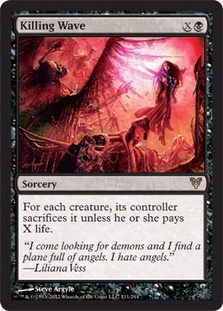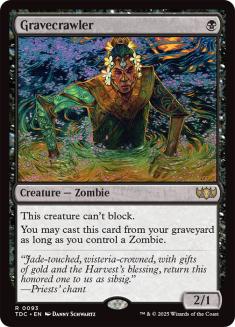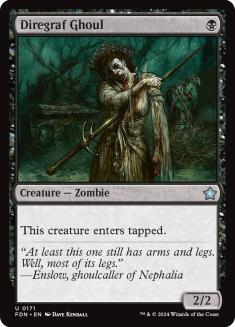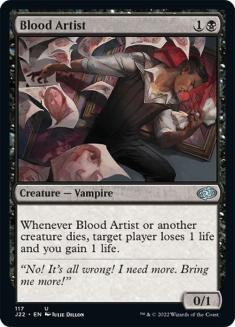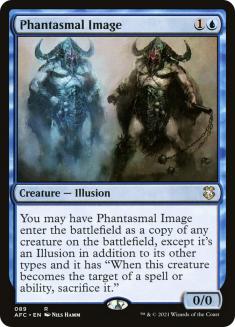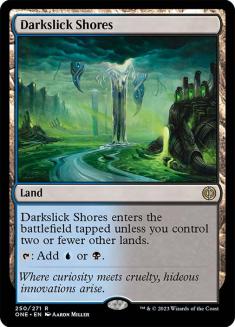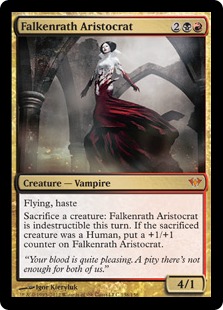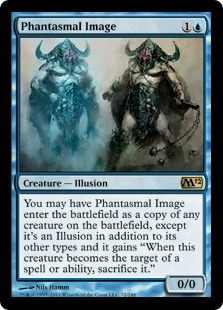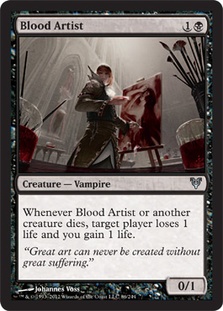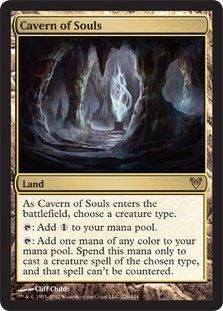“I come looking for Demons and I find a place full of Angels. I hate Angels.” — Liliana Vess (except Restoration Angel)
Creatures (29)
- 4 Phantasmal Image
- 4 Diregraf Ghoul
- 4 Gravecrawler
- 4 Falkenrath Aristocrat
- 4 Geralf's Messenger
- 3 Diregraf Captain
- 2 Highborn Ghoul
- 4 Blood Artist
Lands (23)
Spells (8)
Sideboard

Killing Wave
Killing Wave was mistitled in development; its real name could have easily been Finishing Wave because that’s what it actually does. It’s a board sweeper to most, but if you look a lot deeper you begin to realize its true use as the top of your curve: an Overrun effect. Let’s start with this hand:
This hand is fairly typical for an aggressive start; the only card missing that you really want in this situation is a Killing Wave. At any point if we rip one of our three in the deck this hand will be nearly unbeatable against a majority of the field. What happens is you apply such quick pressure that your opponent must answer your one-drops very quickly or plan to board sweep you. However, your turn 2 usually consists of a Blood Artist, leaving you a Gravecrawler and a Blood Artist on the board. You’ve got in two damage to this point and pass your turn.Â
Your turn 3 play is probably Phantasmal Image the Blood Artist, and at this point your Gravecrawler can attack because you are ok whatever they have blocking, especially if they trade. With your opponent at sixteen life, your Killing Wave could actually win the game if you pull a Geralf’s Messenger at this point. You cast Geralf’s Messenger and do an additional two damage, have your Gravecrawler attack if he’s still around, and then you can Killing Wave for a single black mana to do a direct one-shot kill.
There are far too many scenarios to play out, and some may cry, “Magical Christmasland!” However, it’s really not. The deck is extremely consistent, and Killing Wave is often a game ender along with our new friend Falkenrath Aristocrat.
Falkenrath Aristocrat
I’m a little disappointed I didn’t see this earlier because I feel this is the final piece to this puzzle. It may seem ludicrous to add an additional color for a single card, but it’s far too perfect, powerful, and most importantly, game ending to exclude. The primary question of adding this was, “Can I make the mana work?” and the answer ended up being yes. That’s not to say you can’t be off color from time to time, but the deck has enough of a black mana draw that it can win with just finding one of the splashed colors.
You have the situation noted above where you draw the Blood Artist win condition plan and your early turns are based on that. Or you have the draws where it’s just your typical Zombies draw, hitting your curve well and slamming a Geralf’s Messenger. This draw is the full on aggro draw and can outrace most any deck. Phantasmal Image, Diregraf Captain, and Falkenrath Aristocrat contribute to both of these plans.
As a side note, the Blood Artist win condition will be discussed when we talk about our friend Blood Artist and his breakdown.
One of the small weaknesses I noticed in my testing was if you couldn’t get a decent board presence going it was a lot harder to win. Falkenrath Aristocrat can be extremely aggressive if you curve out well, almost always winning the game if you have one to two creatures out. But there are times, mostly on the draw, where you may have not been able to hold your creatures on the board due to Pillar of Flame, Celestial Purge, Oblivion Ring, etc.
At this point you’d almost always just run out of gas and you are in a position of hitting runner-runner for outs. Falkenrath Aristocrat can come in on turn 4 and literally outrace your opponent as a standalone card because their turns have been spent answering your guys. If she sticks for a whole turn and you have a follow up creature, you can completely turn the tides of battle.
I haven’t even discussed the sick part yet!
Falkenrath Aristocrat helps both on the draw games and on the play. But on both ends of that spectrum, she does a whole lot more. Your board is Gravecrawler, Blood Artist, and Falkenrath Aristocrat (I’ll keep it reasonable, but trust me, it can easily be unreasonable). For however much mana you have, you can basically turn Gravecrawler into a Koth of the Hammer ultimate for all your lands. And that’s not counting the Gravecrawler already bashing in for two to four damage. This also protects your Falkenrath Aristocrat against a lot of removal.
This deck is a deck you want to overextend with, and Falkenrath Aristocrat makes that a whole lot easier. Even when you get board swept early with a Blood Artist in play it can still put you in a rough spot, but let’s say you have a Falkenrath Aristocrat on the board and your opponent goes to Whipflare, Day of Judgment, etc. Your Falkenrath is going to live in this situation, and if one of those creatures was a Gravecrawler, it’s most likely coming back next turn.
Please don’t overlook the fact that she has haste!!!
Phantasmal Image
This is Phantasmal Image’s true home. Prior to this deck, I think the most powerful I ever saw Phantasmal Image was either the Sam Black Esper Spirits deck or Solar Flare. Both of those decks had multiple uses and targets, but here in B/U Aggro (aka Kamikaze) we have even more good targets.
Using it as removal is generally the last thing you want to do, but it does work well in situations where you need it. Here are the primary targets you generally hit, in order of importance the majority of the time.
- Blood Artist — Pretty simple: the more Blood Artists you fill the board with, the less outs your opponents have. It’s basically going for the inevitable win in just one to two turns once you can get two to three of these out.
- Geralf’s Messenger — Its direct damage with undying so it can recopy another target. With so many sacrifice outlets, Phantasmal Image can do a ton of damage here as well.
- Diregraf Captain — Having multiple Captains makes for some large pump on your team, but maybe even more importantly is you can stall the board with a deathtouch creature. Also, each Captain will do a direct damage to the opponent if they’re swept together.
- Falkenrath Aristocrat — It’s not legendary!
- Gravecrawler — In certain decks it’s correct to follow up with a turn 2 beater. Filling your board is a plus, especially if you’re packing a Blood Artist.
Basically the entire deck is full of reasonable targets. However, there are always your opponent’s creatures, too!
Blood Artist
This is the card the deck is built around: our sick friend Blood Artist (no really, have you looked at the art!?). Luckily, it just so happens that this deck clicks just as aggressively as pre-Avacyn Restored Zombies without it. But it adds a completely new win condition on its own, and it allows us the broken interactions as discussed above.
One of the most overlooked aspects of Blood Artist is that he is a form of evasion. B/U Aggro (Kamikaze) uses eight aggressive one-drop creatures, which allows us to attack early and often. When you put a Blood Artist or two on the table, your one-drops turn into Shocks and Lightning Bolts because blocking them becomes even less profitable than just letting them through. It’s these draws that really open up Killing Wave as a finisher.
Just picture Blood Artist sitting in his room painting his art while the chaos around him ensues; nothing fazes him, he just keeps on painting and doing his thing. That’s what Blood Artist is doing in actuality. He drains life so incredibly fast that before you know it, you can literally win out of nowhere.
He is powerful enough that your games that seem to draw out a little longer can easily be won without combat via Blood Artist. In fact, it’s sometimes correct to slow roll a Blood Artist or two and drop them midgame if your early game can’t kill them. Dropping two Blood Artists in a turn can win the game on your next turn if left untouched.
Blood Artists also serve as a great tool to outrace other creature decks because the life gain can be extremely important. This is putting things modestly. The only opponent your life would be irrelevant against is control.
Zombies always needed a better two-drop. Blood Artist isn’t just a slight upgrade; it’s far and beyond the best two-drop in a deck like this. It’s an aggressive card but doubles as a combo card, and B/U Aggro (Kamikaze) runs all the best tools to abuse him.
The Rest of the Deck
There may not be a better home for Cavern of Souls than B/U Aggro (Kamikaze). This deck relies heavily on creating board presence, but if your spells can’t hit the board it’s often a difficult position. If that wasn’t enough they give us whatever mana we need, which gives both the blue and red splash nine colored options. The way you lay your mana in this deck is incredibly important, and I recommend practicing it before you take it to a tournament.
Cavern of Souls is a card you want to lay down last most of the time (unless you are facing counterspells), because it’s not until turn 3 and 4 that you know what mana sources you need. The best part, though, is that we only have three creature types, and if you draw a dual land you will almost always be able to lay Cavern knowing your mana will work the rest of the game.
The removal options have varied, and they may still vary depending what the metagame looks like. But Dismember has been really useful by being a turn 1 removal spell but doubling as three-mana removal later that nets you life with Blood Artist. Bone Splinter helps us kill any creature doing some additional damage. This is especially true when sacrificing a Geralf’s Messenger with a Blood Artist in play. Overall, Dismember has been more important which is why I’m using the split you see.
23 lands may look low, but the deck only needs four lands on the board to operate and oftentimes three will get there. Flooding is the worst thing that can happen, so this land count feels accurate.
The sideboard is crafted knowing full well what types of cards we struggle against. This includes Snapcaster Mage targeting removal spells, hence the Crypt Creepers. Act of Aggression is for the plethora of ramp decks around. Ratchet Bomb is for both Delver decks and token decks. Lingering Souls can stall us long enough to where we really need to respect it and clear the way, but Ratchet Bomb also doubles as some crazy damage with Blood Artist on occasion.
Despise is an unfortunate requirement, but Mirran Crusader is mostly too good against us. Luckily, Despise doubles up as important hand disruption against heavy planeswalker decks and any other place you feel necessary. It’s not a great addition against Delver or Kessig Wolf Run decks though.
I hope this helps interested Humans (players) understand exactly what the deck’s overall strategies are. I hope that you can decide the best sideboard strategies on your own, because quite frankly I don’t know the right answers yet.
 The Vampires are converting Humans every day; are you ready for #TeamBloodArtist?

